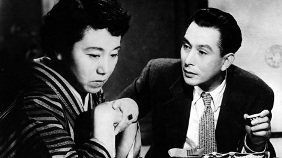A portrait of three former geishas struggling with the challenges of middle age in postwar Tokyo, Late Chrysanthemums, a 1954 film directed by Mikio Naruse, weaves several short stories by Fumiko Hayashi into a flawless tapestry of social observation.
We first meet Kin (played by Haruko Sugimura) as she discusses her rental properties with a financial advisor, instructing him on the upcoming eviction of a widow. She’s a moneylender as well as a landlady, and her single-minded obsession with wealth has hardened her against having compassion for others, or having any kind of an emotional life at all. But she still bears the scars of one of her love affairs, with a man who attempted to carry out a double suicide pact with her in Manchuria—a plan she rejected, instead sending the man to jail. Now she hears that he is in the neighborhood looking for her. We then follow her as she collects her rents, and we meet some of her tenants who were her friends when they were all geishas during the war, including Tomi (Yûko Mochizuki), humorous and talkative, who has become addicted to gambling and resents Kin’s superior air even as she becomes financially indebted to her; and Tamae (Chikako Hosokawa), her housemate, who makes a meager living as a cleaning woman while she supports her adult son, who seems unsure of what to do with his life. Meanwhile Tomi’s light-hearted daughter decides to get married without fussing about elaborate rituals or parental approval. Tomi and Tamae are both disappointed in their children, whose free-and-easy attitudes mark the generational sea change in Japan after the war. Meanwhile, Kin’s mercenary tendencies mask a secret need for love, which reveals itself when she receives a letter from an ex-officer and former lover who is planning to visit.
Each story in this complex film branches off into other stories, and each character connects in subtle ways to all the others. The exterior shots of the narrow bustling streets in the urban neighborhoods are full of life, contrasting with the gracefully controlled set-ups of the interior scenes. Naruse’s pace is so perfectly attuned to the story that the shots seem to flow in and out of one another like musical themes. The final sequences feature a masterful back-and-forth cross-cutting between two different scenes that creates the film’s visual and emotional climax. There is never anything heavy or overwrought about the picture. The tone is persistently realistic, intellgent, and often wryly amusing.
I had become accustomed to a certain emphatic acting style in Japanese films, which I took to be typical of a highly emotional and dramatic stance towards the struggles of life. But the acting in Late Chrysanthemums has challenged my assumptions. All the dialogue in the film, and the behavior, is direct, natural, and understated. The performances are marvelously convincing and many-hued. Above all, the film is modern in style and sensibility. The idiosyncrasies of the women are apparent (as in the wonderful, loquacious, cigarette-smoking Tomi) but the film doesn’t try to make too much of this, so we end up identifying with the characters instead of judging them. Naruse always seems to find the right shot, the right cut, and the right response from his performers. Like the greatest artists in any medium, he makes it look easy. Late Chrysanthemums is beautiful and absorbing from start to finish.


